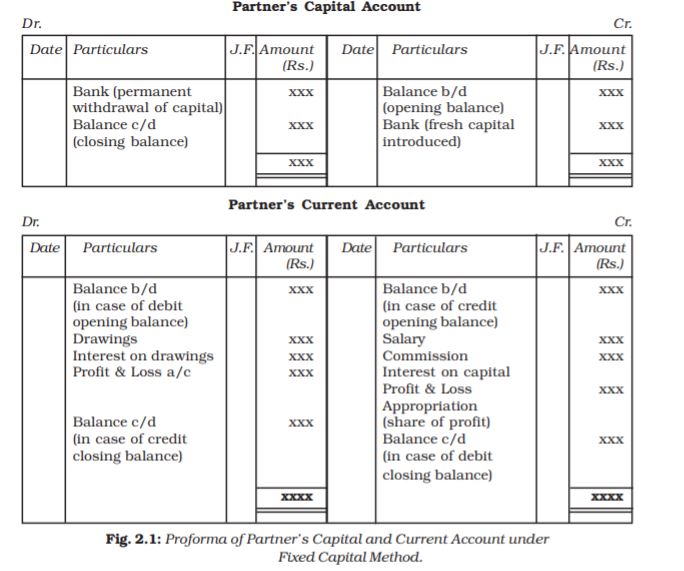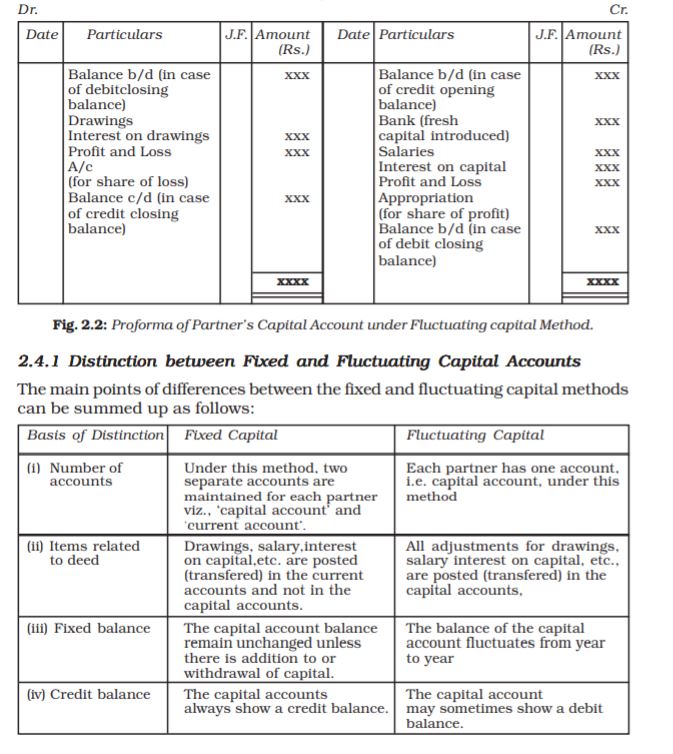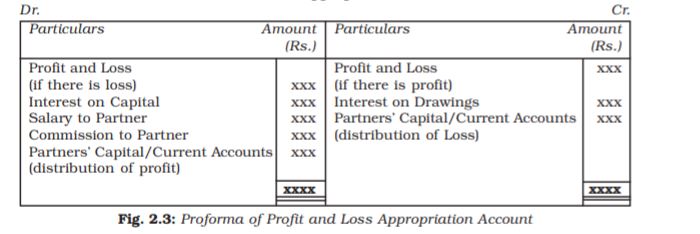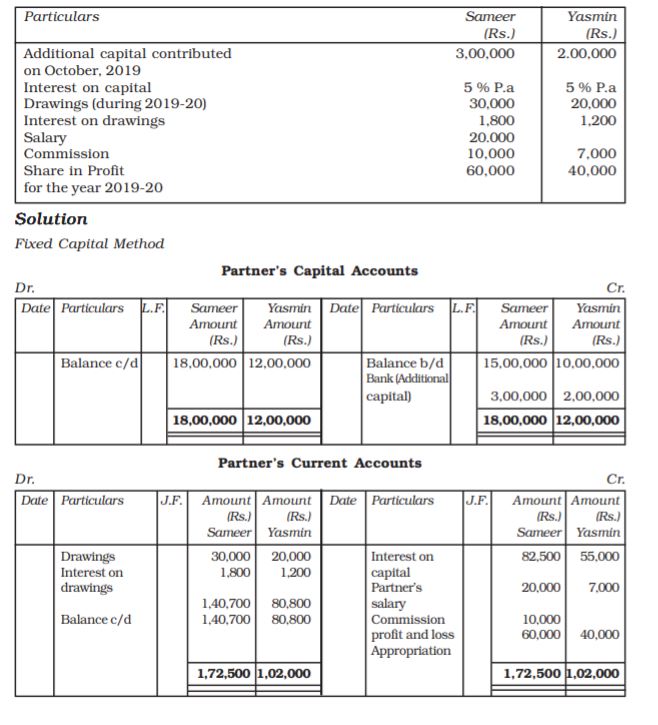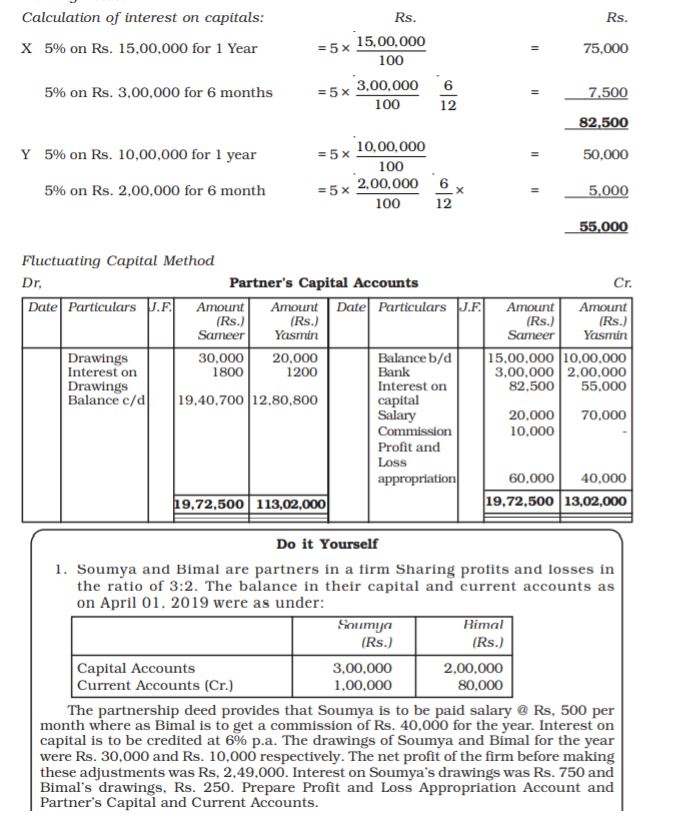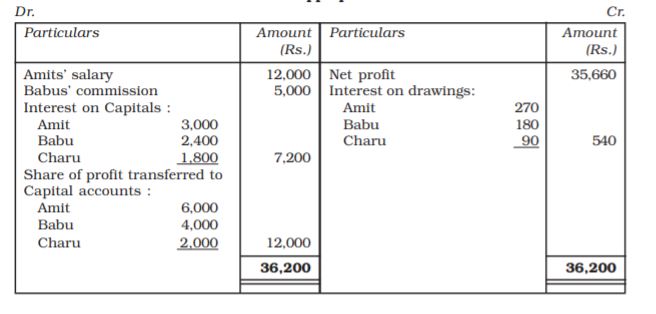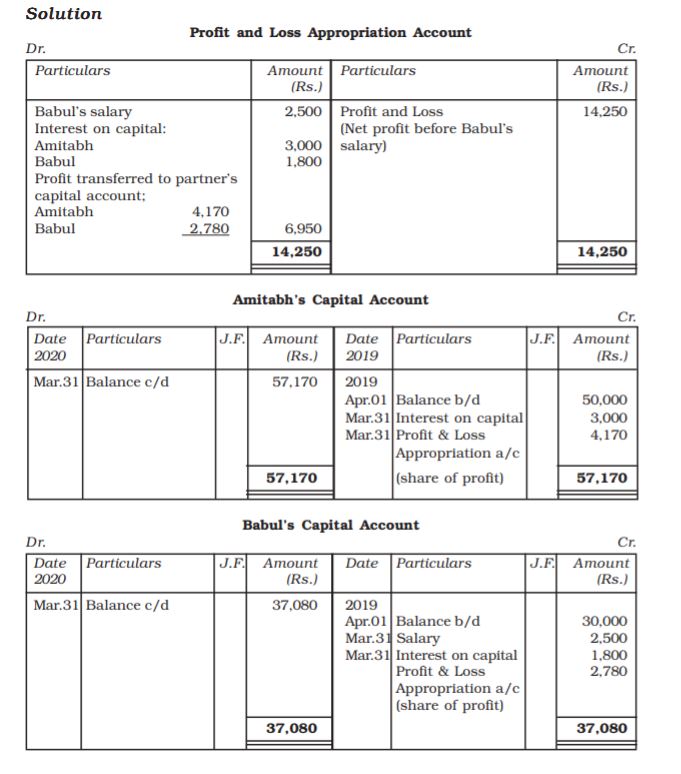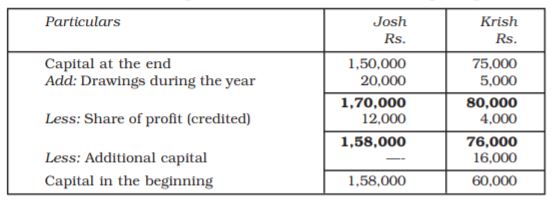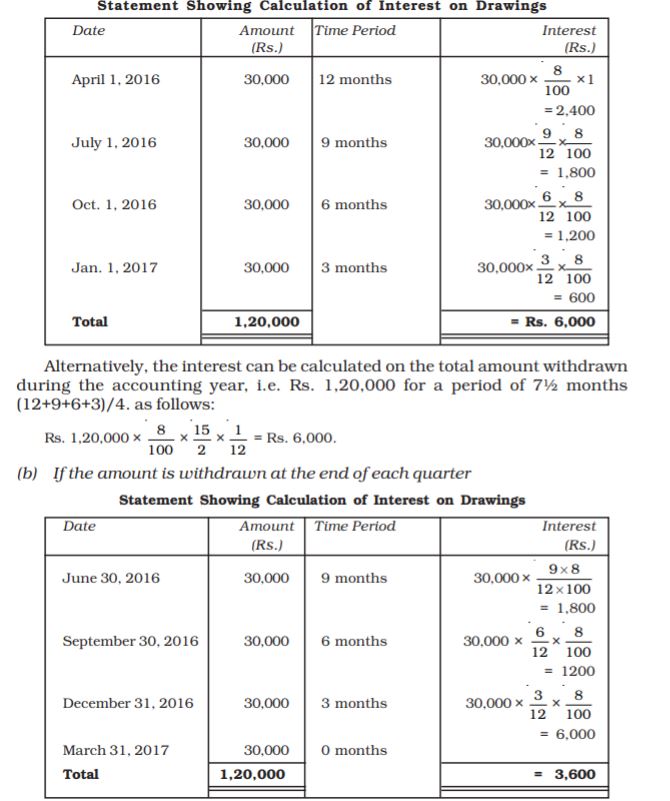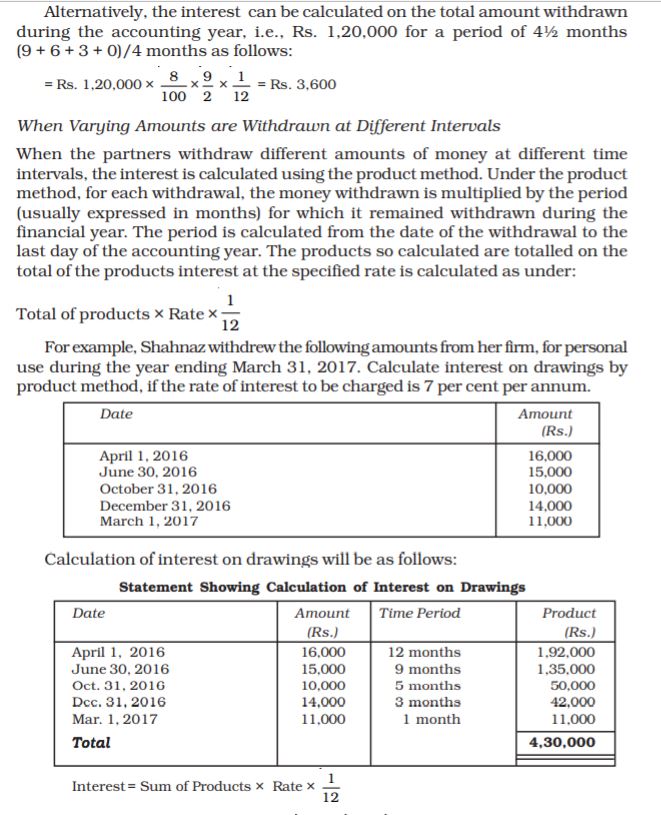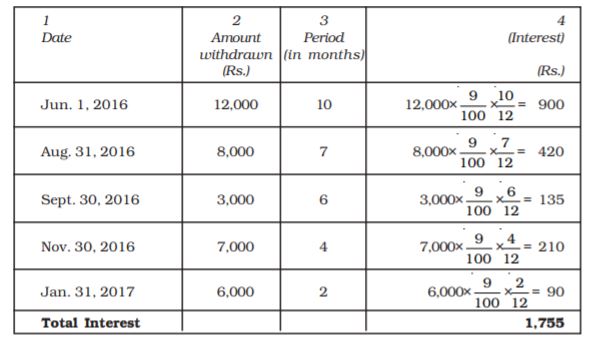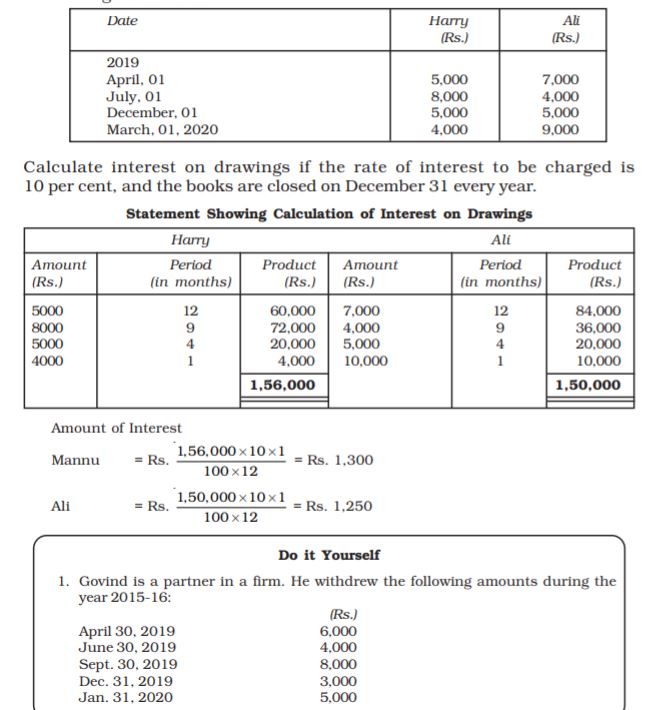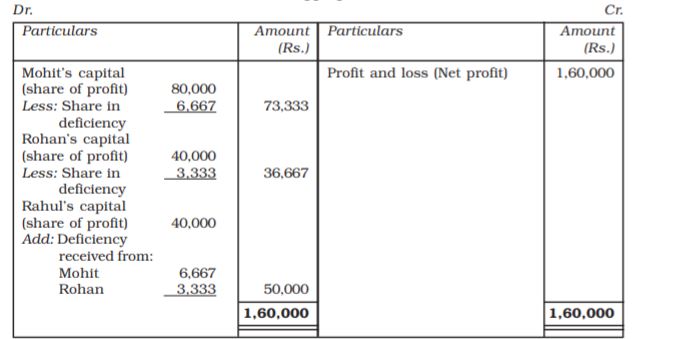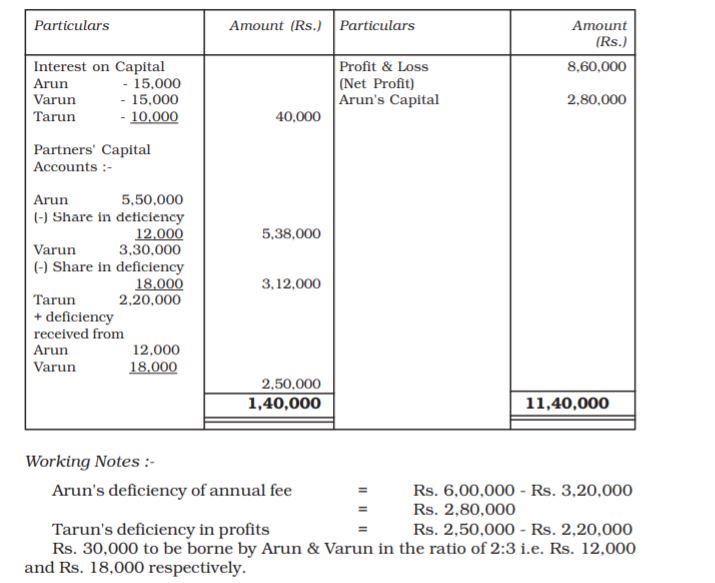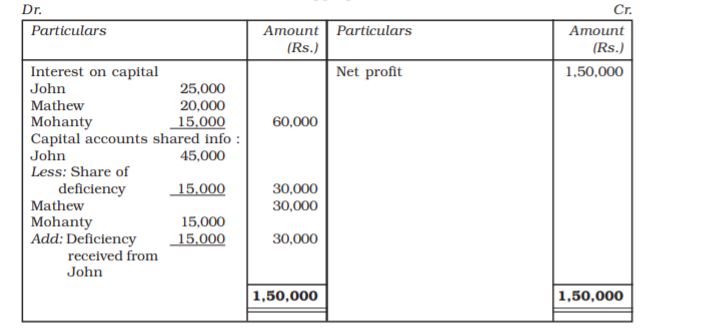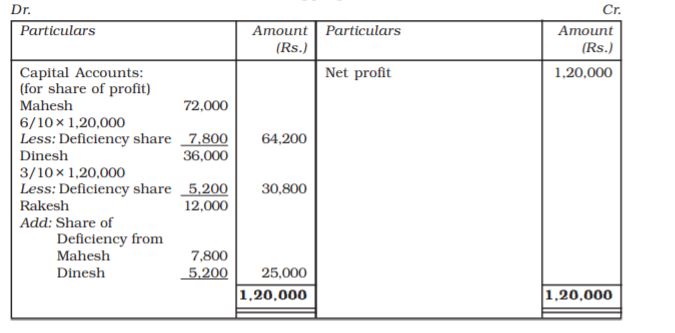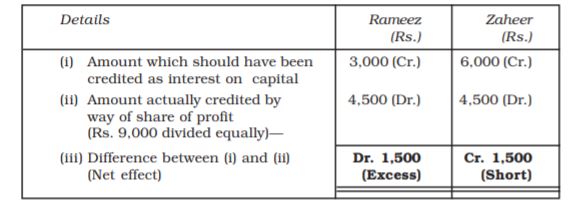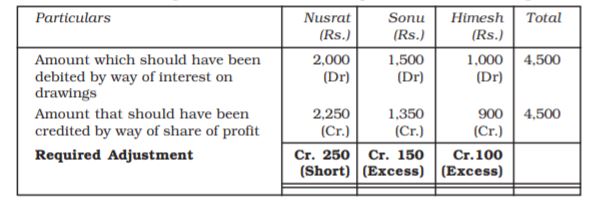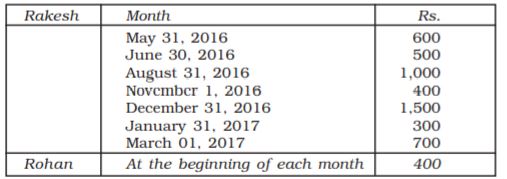Table of Contents

2
Accounting for Partnership : Basic Concepts
Learning Objectives
After studying this chapter, you will be able to :
• Define partnership and list its essential features;
• Identify the provisions of the Indian Partnership Act 1932 that are relevant for accounting;
• Prepare partners’ capital accounts under fixed and fluctuating capital methods;
• Explain the distribution profit or loss among the partners and prepare the Profit and Loss Appropriation Account;
• Calculate interest on capital and drawing under various situations;
• Explain how guarantee for a minimum amount of profit affects the distribution of profits among the partners;
• Make necessary adjustments to rectify the past errors in partners capital accounts; and
• Prepare final accounts of a partnership firm;
You have learnt about the preparation of final accounts for a sole proprietary concern. As the business expands, one needs more capital and larger number of people to manage the business and share its risks. In such a situation, people usually adopt the partnership form of organisation. Accounting for partnership firms has it’s own peculiarities, as the partnership firm comes into existence when two or more persons come together to establish business and share its profits. On many issues affecting distribution of profits, there may not be any specific agreement between the partners. In such a situation the provisions of the Indian Partnership Act 1932 apply. Similarly, calculation of interest on capital, interest on drawings and maintenance of partners capital accounts have their own peculiarities. Not only that a variety of adjustments are required on the death of a partner or when a new partner is admitted and so on. These peculiar situations need specific treatment in accounting that need to be clarified.
The present chapter discusses some basic aspects of partnership such as distribution of profit, maintenance of capital accounts, etc. The treatment of situations like admission of partner, retirement, death and dissolution have been taken up in the subsequent chapters.
2.1 Nature of Partnership
When two or more persons join hands to set up a business and share its profits and losses, they are said to be in partnership. Section 4 of the Indian Partnership Act 1932 defines partnership as the ‘relation between persons who have agreed to share the profits of a business carried on by all or any of them acting for all’.
Persons who have entered into partnership with one another are individually called ‘partners’ and collectively called ‘firm’. The name under which the business is carried is called the ‘firm’s name’. A partnership firm has no separate legal entity, apart from the partners constituting it. Thus, the essential features of partnership are:
1. Two or More Persons: In order to form partnership, there should be at least two persons coming together for a common goal. In other words, the minimum number of partners in a firm can be two. There is however, a limit on their maximum number. By virtue of Section 464 of the Companies Act 2013, the Central Government is empowered to prescribe maximum number of partners in a firm but the number of partners can not be more than 100. The Central government has prescribed the maximum number of partness in a firm to be 50.
2. Agreement: Partnership is the result of an agreement between two or more persons to do business and share its profits and losses. The agreement becomes the basis of relationship between the partners. It is not necessary that such agreement is in written form. An oral agreement is equally valid. But in order to avoid disputes, it is preferred that the partners have a written agreement.
3. Business: The agreement should be to carry on some business. Mere co-ownership of a property does not amount to partnership. For example, if Rohit and Sachin jointly purchase a plot of land, they become the joint owners of the property and not the partners. But if they are in the business of purchase and sale of land for the purpose of making profit, they will be called partners.
4. Mutual Agency: The business of a partnership concern may be carried on by all the partners or any of them acting for all. This statement has two important implications. First, every partner is entitled to participate in the conduct of the affairs of its business. Second, that there exists a relationship of mutual agency between all the partners. Each partner carrying on the business is the principal as well as the agent for all the other partners. He can bind other partners by his acts and also is bound by the acts of other partners with regard to business of the firm. Relationship of mutual agency is so important that one can say that there would be no partnership, if the element of mutual agency is absent.
5. Sharing of Profit: Another important element of partnership is that, the agreement between partners must be to share profits and losses of a business. Though the definition contained in the Partnership Act describes partnership as relation between people who agree to share the profits of a business, the sharing of loss is implied. Thus, sharing of profits and losses is important. If some persons join hands for the purpose of some charitable activity, it will not be termed as partnership.
6. Liability of Partners: Each partner is liable jointly with all the other partners and also severally to the third party for all the acts of the firm done while he is a partner. Not only that the liability of a partner for acts of the firm is also unlimited. This implies that his private assets can also be used for paying off the firm’s debts.
2.2 Partnership Deed
Partnership comes into existence as a result of agreement among the partners. The agreement can be either oral or written. The Partnership Act does not require that the agreement must be in writing. But wherever it is in writing, the document, which contains terms of the agreement is called ‘Partnership Deed’. It generally contains the details about all the aspects affecting the relationship between the partners including the objective of business, contribution of capital by each partner, ratio in which the profits and the losses will be shared by the partners and entitlement of partners to interest on capital, interest on loan, etc.
The clauses of partnership deed can be altered with the consent of all the partners. The deed should be properly drafted and prepared as per the provisions of the ‘Stamp Act’ and preferably registered with the Registrar of Firms.
Contents of the Partnership Deed
The Partnership Deed usually contains the following details:
• Names and Addresses of the firm and its main business;
• Names and Addresses of all partners;
• Amount of capital to be contributed by each partner;
• The accounting period of the firm;
• The date of commencement of partnership;
• Rules regarding operation of Bank Accounts;
• Profit and loss sharing ratio;
• Rate of interest on capital, loan, drawings, etc;
• Mode of auditor’s appointment, if any;
• Salaries, commission, etc, if payable to any partner;
• The rights, duties and liabilities of each partner;
• Treatment of loss arising out of insolvency of one or more partners;
• Settlement of accounts on dissolution of the firm;
• Method of settlement of disputes among the partners;
• Rules to be followed in case of admission, retirement, death of a partner; and
• Any other matter relating to the conduct of business.
Normally, the partnership deed covers all matters affecting relationship of partners amongst themselves. However, if there is no express agreement on certain matters, the provisions of the Indian Partnership Act, 1932 shall apply.
2.2.1 Provisions of Partnership Act Relevant for Accounting
The important provisions affecting partnership accounts are as follows:
(a) Profit Sharing Ratio: If the partnership deed is silent about the profit sharing ratio, the profits and losses of the firm are to be shared equally by partners, irrespective of their capital contribution in the firm.
(b) Interest on Capital: No partner is entitled to claim any interest on the amount of capital contributed by him in the firm as a matter of right. However, interest can be allowed when it is expressly agreed to by the partners. Thus, no interest on capital is payable if the partnership deed is silent on the issue.
(c) Interest on Drawings: No interest is to be charged on the drawings made by the partners, if there is no mention in the Deed.
(d) Interest on Loan: If any partner has advanced loan to the firm for the purpose of business, he/she shall be entitled to get an interest on the loan amount at the rate of 6 per cent per annum.
(e) Remuneration for Firm’s Work: No partner is entitled to get salary or other remuneration for taking part in the conduct of the business of the firm unless there is a provision for the same in the Partnership Deed.
Apart from the above, the Indian Partnership Act specifies that subject to contract between the partners:
(i) If a partner derives any profit for him/her self from any transaction of the firm or from the use of the property or business connection of the firm or the firm name, he/she shall account for the profit and pay it to the firm.
(ii) If a partner carries on any business of the same nature as and competing with that of the firm, he/she shall account for and pay to the firm, all profit made by him/her in that business.
Test your Understanding – I
1. Mohan and Shyam are partners in a firm. State whether the claim is valid if the partnership agreement is silent in the following matters:
(i) Mohan is an active partner. He wants a salary of Rs. 10,000 per year;
(ii) Shyam had advanced a loan to the firm. He claims interest @ 10% per annum;
(iii) Mohan has contributed Rs. 20,000 and Shyam Rs. 50,000 as capital. Mohan wants equal share in profits.
(iv) Shyam wants interest on capital to be credited @ 6% per annum.
2. State whether the following statements are true or false:
(i) Valid partnership can be formulated even without a written agreement between the partners;
(ii) Each partner carrying on the business is the principal as well as the agent for all the other partners;
(iii) Maximum number of partners can be 50;
(iv) Methods of settlement of dispute among the partners can’t be part of the partnership deed;
(v) If the deed is silent, interest at the rate of 6% p.a. would be charged on the drawings made by the partner;
(vi) Interest on partner’s loan is to be given @ 12% p.a. if the deed is silent about the rate.
2.3 Special Aspects of Partnership Accounts
Accounting treatment for partnership firm is similar to that of a sole proprietorship business with the exception of the following aspects:
• Maintenance of Partners’ Capital Accounts;
• Distribution of Profit and Loss among the partners;
• Adjustments for Wrong Appropriation of Profits in the Past;
• Reconstitution of the Partnership Firm; and
• Dissolution of Partnership Firm.
The first three aspects mentioned above have been taken up in the following sections of this chapter. The remaining aspects have been covered in the subsequent chapters.
2.4 Maintenance of Capital Accounts of Partners
All transactions relating to partners of the firm are recorded in the books of the firm through their capital accounts. This includes the amount of money brought in as capital, withdrawal of capital, share of profit, interest on capital, interest on drawings, partner’s salary, commission to partners, etc.
There are two methods by which the capital accounts of partners can be maintained. These are: (i) fixed capital method, and (ii) fluctuating capital method. The difference between the two lies in whether or not the transactions other than addition/withdrawal of capital are recorded in the capital accounts of the partners.
(a) Fixed Capital Method: Under the fixed capital method, the capitals of the partners shall remain fixed unless additional capital is introduced or a part of the capital is withdrawn as per the agreement among the partners. All items like share of profit or loss, interest on capital, drawings, interest on drawings, etc. are recorded in a separate accounts, called Partner’s Current Account. The partners’ capital accounts will always show a credit balance, which shall remain the same (fixed) year after year unless there is any addition or withdrawal of capital. The partners’ current account on the other hand, may show a debit or a credit balance. Thus under this method, two accounts are maintained for each partner viz., capital account and current account, While the partners’ capital accounts shall always appear on the liabilities side in the balance sheet, the partners’ current account’s balance shall be shown on the liabilities side, if they have credit balance and on the assets side, if they have debit balance.
The partner’s capital account and the current account under the fixed capital method would appear as shown below:
Partner’s Capital Account
(b) Fluctuating Capital Method: Under the fluctuating capital method, only one account, i.e. capital account is maintained for each partner. All the adjustments such as share of profit and loss, interest on capital, drawings, interest on drawings, salary or commission to partners, etc are recorded directly in the capital accounts of the partners. This makes the balance in the capital account to fluctuate from time to time. That’s the reason why this method is called fluctuating capital method. In the absence of any instruction, the capital account should be prepared by this method. The proforma of capital accounts prepared under the fluctuating capital method is given below:
Partner’s Capital Account
2.5.1 Profit and Loss Appropriation Account
Profit and Loss Appropriation Account is merely an extension of the Profit and Loss Account of the firm. It shows how the profits are appropriated or distributed among the partners. All adjustments in respect of partner’s salary, partner’s commission, interest on capital, interest on drawings, etc. are made through this account. It starts with the net profit/net loss as per Profit and Loss Account. The journal entries for preparation of Profit and Loss Appropriation Account and making various adjustments through it are given as follows:
Journal Entries
1. Transfer of the balance of Profit and Loss Account to Profit and Loss Appropriation Account:
(a) If Profit and Loss Account shows a credit balance (net profit):
Profit and Loss A/c Dr.
To Profit and Loss Appropriation A/c
(b) If Profit and Loss Account shows a debit balance (net loss)
Profit and Loss Appropriation A/c Dr.
To Profit and Loss A/c
2. Interest on Capital:
(a) For Allowing interest on capital:
Interest on Capital A/c Dr.
To Partner’s Capital/Current A/cs (individually)
(b) For transferring interest on capital to Profit and Loss Appropriation Account:
Profit and Loss Appropriation A/c Dr.
To Interest on Capital A/c
3. Interest on Drawings:
(a) For charging interest on drawings to partners’ capital accounts:
Partners Capital/Current A/c’s (individually) Dr.
To Interest on Drawings A/c
(b) For transferring interest on drawings to Profit and Loss Appropriation Account: Interest on Drawings A/c Dr.
To Profit and Loss Appropriation A/c
4. Partner’s Salary:
(a) For Allowing partner’s salary to partner’s capital account:
Salary to Partner A/c Dr.
To Partner’s Capital/Current A/c’s (individually)
(b) For transferring partner’s salary to Profit and Loss Appropriation Account:
Profit and Loss Appropriation A/c Dr.
To Salary to Partner’s A/c
5. Partner’s Commission:
(a) For crediting commission allowed to a partner, to partner’s capital account:
Commission to Partner A/c Dr.
To Partner’s Capital/Current A/c’s (individually)
(b) For transferring commission allowed to partners to Profit and Loss Appropriation Account.
Profit and Loss Appropriation A/c Dr.
To Commission to Partners Capital/Current A/c
6. Share of Profit or Loss after appropriations:
(a) If Profit:
Profit and Loss Appropriation A/c Dr.
To Partner’s Capital/Current A/c’s (individually)
(b) If Loss:
Partner’s Capital/Current A/c (individually)
To Profit and Loss Appropriation A/c
Note: In case firm suffers a loss, no interest on capital, salary, remuneration is to be allowed to partners.
The Proforma of Profit and Loss Appropriation Account is given as follows:
Profit and Loss Appropriation Account
Illustration 1
Sameer and Yasmin are partners with capitals of Rs.15,00,000 and Rs. 10,00,000 respectively. They agree to share profits in the ratio of 3:2. Show how the following transactions will be recorded in the capital accounts of the partners in case:
(i) the capitals are fixed, and (ii) the capitals are fluctuating. The books are closed on March 31, every year.
2. Soniya, Charu and Smita started a partnership firm on April 1, 2019. They contributed Rs, 5,00,000, Rs. 4,00,000 and Rs. 3,00,000 respectively as their capitals and decided to share profits and losses in the ratio of 3:2:1.
The partnership deed provides that Soniya is to be paid a salary of Rs. 10,000 per month and Charu a commission of Rs. 50,000. It also provides that interest on capital be allowed @6% p.a. The drawings for the year were Soniya Rs. 60,000, Charu Rs. 40,000 and Smita Rs. 20,000. Interest on drawings was charged as Rs. 2,700 on Soniya’s drawings, Rs. 1,800 on Charu’s drawings and Rs. 900 on Smita’s drawings. The net amount of profit as per Profit and Loss Account for the year 2019-2020 is Rs. 3,56,600.
(i) Record necessary journal entries.
(ii) Prepare profit and loss appropriation account
(iii) Show capital accounts of the partners.
Illustration 2
Amit, Babu and Charu set up a partnership firm on April 1, 2019. They contributed Rs. 50,000, Rs. 40,000 and Rs. 30,000, respectively as their capitals and agreed to share profits and losses in the ratio of 3 : 2 :1. Amit is to be paid a salary of Rs. 1,000 per month and Babu, a Commission of Rs. 5,000. It is also provided that interest to be allowed on capital at 6% p.a. The drawings for the year were Amit Rs. 6,000, Babu Rs. 4,000 and Charu Rs. 2,000. Interest on drawings of Rs. 270 was charged on Amit’s drawings, Rs. 180 on Babu’s drawings and Rs. 90, on Charu’s drawings. The net profit as per Profit and Loss Account for the year ending March 31, 2020 was Rs. 35,660. Prepare the Profit and Loss Appropriation Account to show the distribution of profit among the partners.
Solution
Profit and Loss Appropriation Account
Illustration 3
Yadu, Madhu and Vidu are partners sharing profits and losses in the ratio of 2:2:1. There fixed capitals on April 01, 2019 were; Yadu Rs. 5,00,000, Madhu Rs. 4,00,000 and Vidhu Rs. 3,50,000. As per the partnership deed, partners are entitled to interest on capital @ 5% p.a., and Yadu has to be paid a salary of Rs. 2,000 per month while Vidu would be receiving a commission of Rs. 18,000. Net loss of the firm as per profit and loss account for the year ending March 31, 2019 amounted to Rs. 75,000 on the basis of above information prepare profit and loss appropriation account. Prepare profit and loss appropriation account for the year ending March 31, 2019.
Solution
Books of Yadu, Madhu and Vidu
Profit and Loss Appropriation Account
for the year ending March 31, 2019
Illustration 4
Amitabh and Babul are partners sharing profits in the ratio of 3:2, with capitals of Rs. 50,000 and Rs. 30,000 respectively. Interest on capital is agreed @ 6% p.a. Babul is to be allowed an annual salary of Rs. 2,500. Manager is to be allowed commission Rs. 5,000. Amitabh has also given a Loan on April 01 , 2019 of Rs. 50,00 to the firm without any agreement. During the year 2019-20, the profits earned is Rs. 22,250.
Prepare Profit and Loss Appropriation account showing the distribution of profit and the partners’ capital accounts for the year ending March 31, 2020.
Test your Unerstanding – II
1. Raju and Jai commenced business in partnership on April 1, 2017. No partnership agreement was made whether oral or written. They contributed Rs. 4,00,000 and Rs. 1,00,000 respectively as capitals. In addtion, Raju advanced Rs. 2,00,000 as loan to the firm on October 1, 2017. Raju met with an accident on July 1, 2017 and could not attend the business up to september 30, 2017. The profit for the year ended March 31, 2018 amounted to Rs, 50,600. Disputes have arisen between them on sharing the profits of the firm.
Raju Claims:
(i) He should be given interest at 10% p.a. on capital and so also on loan.
(ii) Profit should be distributed in the proportion of capitals.
Jai Claims:
(i) Net profit should be shared equally.
(ii) He should be allowed remuneration of Rs, 1,000 p.a. during the period of Raju’s illness.
(iii) Interest on capital and loan should be given @ 6% p.a.
State the correct position on each issue as per the provisions of the Partnership Act. 1932.
2. Reena and Raman are partners with capitals of Rs. 3,00,000 and Rs. 1,00,000 respectively. The profit for the year ended March 31, 2017 was Rs. 1,80,000, before paying rent for her personal building to be used as godown for firm to Reena payable at Rs. 5000 per month. Interest on capital is to be allowed at 6% p.a. Raman was entitled to a salary of Rs. 30,000 p.a. The drawings of partners were Rs. 30,000 and 20,000. The interest on drawings to be charged to Reena was Rs. 1,000 and to Raman, Rs. 500.
Assuming that Reena and Raman are equal partners. State their share of profit after necessary appropriations.
Note: Payment of Rent to Reena is an expense for the business. Hence, it is change against profits.
2.5.2 Interest on Capital
No interest is allowed on partners’ capitals unless it is expressly agreed among the partners. When the Deed specifically provides for it, interest on capital is credited to the partners at the agreed rate with reference to the time period for which the capital remained in business during a financial year. Interest on capital is generally provided for in two situations: (i) when the partners contribute unequal amounts of capitals but share profits equally, and (ii) where the capital contribution is same but profit sharing is unequal.
Interest on capital is calculated with due allowance for any addition or withdrawal of capital during the accounting period. For example, Mohini, Rashmi and Navin entered into partnership, bringing in Rs. 3,00,000, Rs. 2,00,000 and Rs. 1,00,000 respectively into the business. They decided to share profits and losses equally and agreed that interest on capital will be provided to the partners @10 per cent per annum. There was no addition or withdrawal of capital by any partner during the year. The interest on capital works out to Rs. 30,000
(10% on 30,000) for Mohini, Rs. 20,000 (10% on 2,00,000) for Rashmi, and Rs. 10,000 (10% on 1,00,000) for Navin.
Take another case of Mansoor and Reshma who are partners in a firm and their capital accounts showed the balance of Rs. 2,00,000 and Rs. 1,50,000 respectively on April 1, 2016. Mansoor introduced additional capital of
Rs. 1,00,000 on August 1, 2016 and Reshma brought in further capital of
Rs. 1,50,000 on October 1, 2016. Interest is to be allowed @ 6% p.a. on the capitals. It shall be worked as follows:
For Mansoor 
= Rs. 12,000 + Rs. 4,000 = Rs. 16,000
For Reshma 
= Rs. 9,000+Rs. 4,500= Rs. 13,500
When there are both addition and withdrawal of capital by the partners during a financial year, the interest on capital is calculated as follows:
(i) On the opening balance of the capital accounts of partners, interest is calculated for the whole year;
(ii) On the additional capital brought in by any partner during the year, interest is calculated from the date of introduction of additional capital to the last day of the financial year.
(iii) In case of withdrawal of capital, interest on capital will be calculated as:
On opening capital from the beginning of the year till date of capital withdrawn and then on the reduced capital for the remaining time period. Alternatively, it can be calculated with respect of amount remained in business for the relevant period.
Illustration 5
Saloni and Srishti are partners in a firm. Their capital accounts as on April 01. 2016 showed a balance of Rs. 2,00,000 and Rs. 3,00,000 respectively. On July 01, 2016, Saloni introduced additional capital of Rs. 50,000 and Srishti, Rs. 60,000. On October 01 Saloni withdrew Rs. 30,000, and on January 01, 2016 Srishti withdraw, Rs. 15,000 from their capitals. Interest is allowed @ 8% p.a. Calculate interest payable on capital to both the partners during the financial year 2016–2017.
Solution
Statement Showing Calculation of Interest on Capital :
For Saloni (Rs.)
Interest on Rs. 2,00,000 for 3 months  = 4,000
= 4,000
Add : Interest on Rs. 2,50,000 for 3 months 
Add : Interest on Rs. 2,20,000 for 6 months  17,800
17,800
For Srishti
(Rs.)
Interest on Rs. 3,00,000 for 3 months  = 6,0300
= 6,0300
Add : Interest on Rs. 3,60,000 for 6 months 
Add : Interest on Rs. 2,20,000 for 3 months  = 300
= 300
Sometimes opening capitals of partners may not be given. In such a situation before calculation of interest on capital the opening capitals will have to be worked out with the help of partners’ closing capitals by marking necessary adjustments for the additions and withdrawal of capital, drawings, share of profit or loss, if already shown in the capital accounts the partners.
Illustration 6
Josh and Krish are partners sharing profits and losses in the ratio of 3:1. Their capitals at the end of the financial year 2015-2016 were Rs. 1,50,000 and
Rs. 75,000. During the year 2015-2016, Josh’s drawings were Rs. 20,000 and the drawings of Krish were Rs. 5,000, which had been duly debited to partner’s capital accounts. Profit before charging interest on capital for the year was Rs. 16,000. The same had also been debited in their profit sharing ratio. Krish had brought additional capital of Rs. 16,000 on October 1, 2015. Calculate interest on capital @ 12% p.a. for the year 2015-2016.
Solution
Statement Showing Calculation of Capital at the Beginning
Interest on capital will be as 18,960 (12% of Rs. 1,58,000) for Josh and Rs. 960 for krish calculated as follows:
 = Rs. 7,200 + Rs. 960
= Rs. 7,200 + Rs. 960
= Rs. 8,160.
As clarified earlier, the interest on capital is allowed only when the firm has earned profit during the accounting year. Hence, no interest will be allowed during the year the firm has incurred net loss and if in a year, the profit of the firm is less than the amount due to the partners as interest on capital, the payment of interest will be restricted to the amount of profits. In that case, the profit will be effectively distributed in the ratio of interest on capital of each partner.
Illustration 7
Anupam and Abhishek are partners sharing profits and losses in the ratio of 3 : 2. Their capital accounts showed balances of Rs. 1,50,000 and Rs. 2,00,000 respectively on Jan 01, 2017. Show the calculation of interest on capital for the year ending December 31, 2017 in each of the following alternatives:
(a) If the partnership deed is silent as to the payment of interest on capital and the profit for the year is Rs. 50,000;
(b) If partnership deed provides for interest on capital @ 8% p.a. and the firm incurred a loss of Rs. 10,000 during the year;
(c) If partnership deed provides for interest on capital @ 8% p.a. and the firm earned a profit of Rs. 50,000 during the year;
(d) If the partnership deed provides for interest on capital @ 8% p.a. and the firm earned a profit of Rs. 14,000 during the year.
Solution
(a) In the absence of a specific provision in the Deed, no interest will be paid on the capital to the partners. The whole amount of profit will however be distributed among the partners in their profit sharing ratio.
(b) As the firm has incurred losses during the accounting year, no interest on capital will be allowed to any partner. The firm’s loss will however be shared by the partners in their profit sharing ratio.
Rs. .
(c) Interest to Anupam @ 8% on Rs. 1,50,000 = 12,000
Interest to Abhishek @ 8% on Rs. 2,00,000 = 16,000

28,000

As the profit is sufficient to pay interest at agreed rate, the whole amount of interest on capital shall be allowed and the remaining profit amounting to
Rs. 22,000 (Rs. 50,000 – Rs. 28,000) shall be shared by the partners in their profit sharing ratio.
(d) As the profit for the year is Rs. 14,000, which is less than the amount of interest on capital due to partners, i.e. Rs. 28,000 (Rs. 12,000 for Anupam and Rs. 16,000 for Abhishek), interest will be paid to the extent of available profit i.e., Rs. 14,000. Anupam and Abhishek will be credited with Rs. 6,000 and Rs. 8,000, respectively. Effectively this amounts to sharing the firm’s profit in the ratio of interest on capital, i.e., 3:4.
Test your Understanding – III
1. Rani and Suman are in partnership with fixed capitals of Rs, 80,000 and Rs. 60,000, respectively. During the year 2015-16, Rani withdrew Rs. 10,000 from her capital and Suman Rs. 15,000. Profits before charging interest on capital was Rs. 50,000. Rani and Suman shared profits in the ratio of 3:2. Calculate the amounts of interest on their capitals @ 12% p.a. for the year ended March 31, 2016.
2. Priya and Kajal are partners in a firm, sharing profits and losses in the ratio of 5:3. The balance in their fixed capital accounts, on April 1, 2016 were: Priya, Rs. 6,00,000 and Kajal, Rs. 8,00,000. The profit of the firm for the year ended March 31, 2017 was Rs, 1,26,000. Calculate their shares of profits: (a) when there is no agreement in respect of interest on capital, and (b) when there is an agreement that the interest on capital will be allowed @ 12% p.a.
2.5.3 Interest on Drawings
The partnership agreement may also provide for charging of interest on money withdrawn out of the firm by the partners for their personal use. As stated earlier, no interest is charged on the drawings if there is no express agreement among the partners about it. However if the partnership deed so provides for it, the interest is charged at an agreed rate, for the period for which drawings have been made. Remained outstanding from the partners during an accounting year. Charging interest on drawings discourages excessive amounts of drawings by the partners.
The calculation of interest on drawings under different situations is shown as here under.
When Fixed Amounts was Withdrawn Every Month
Many a time, a fixed amount of money is withdrawn by the partners, at equal time interval, say each month or each quarter. While calculating the time period, attention must be paid to whether the fixed amount was withdrawn at the beginning (first day) of the month, middle of the month or at the end (last day) of the month. If withdrawn on the first day of every month, interest on total amount will be calculated for 6½ months; if withdrawn at the end at every month, it will be calculated for 5½ months, and if withdrawn during the middle of the month, it will be calculated for 6 months.
Suppose, Aashish withdrew Rs. 10,000 per month from the firm for his personal use during the year ending March 31, 2017. The calculation of average period and the interest on drawings, in different situations would be as follows:
(a) When the amount is withdrawn at the beginning of each month:
Average Period =  =
=
 =
=  months.
months.
Interest on Drawings =  = Rs. 5,200.
= Rs. 5,200.
(b) When the amount is withdrawn at the end of each month
Average Period =  =
=
 =
=  months
months
Interest on Drawings =  = Rs. 4,400.
= Rs. 4,400.
(c) When money is withdrawn in the middle of the month
When money is withdrawn in the middle of the month, nothing is added or deduced from the total period.
Average Period =  =
=
6 months
Interest on Drawings =  = Rs. 4,800.
= Rs. 4,800.
When Fixed Amount is withdrawn Quarterly
When fixed amount of money is withdrawn quarterly by partners, in such a situation, for the purpose of calculation of interest, the total period of time is ascertained depending on whether the money was withdrawn at the beginning or at the end of each quarter. If the amount is withdrawn at the beginning of each quarter, the interest is calculated on the total money withdrawn during the year, for a period of seven and half months i.e., and if withdrawn at the and of each quarter it will be calculated for a period of 4½ months, i.e.,
and if withdrawn at the and of each quarter it will be calculated for a period of 4½ months, i.e.,
Suppose Satish and Tilak are partners in a firm, sharing profits and losses equally. During financial year 2016–2017, Satish withdrew Rs. 30,000 quarterly. If interest is to be charged on drawings @ 8% per annum, the calculation of average period and interest on drawings will be as follows:
Illustration 8
John Ibrahm, a partner in Modern Tours and Travels withdrew money during the year ending March 31, 2017 from his capital account, for his personal use. Calculate interest in drawings in each of the following alternative situations, if rate of interest is 9 per cent per annum.
(a) If he withdrew Rs. 3,000 per month at the beginning of the month.
(b) If an amount of Rs. 3,000 per month was withdrawn by him at the end of each month.
(c) If the amounts withdrawn were : Rs. 12,000 on June 01, 2016,
Rs. 8,000; on August 31, 2016, Rs. 3,000; on September 30, 2016,
Rs. 7,000, on November 30, 2016, and Rs. 6,000 on January 31, 2017.
Solution
(a) As a fixed amount of Rs. 3,000 per month is withdrawn at the beginning of the month, interest on drawings will be calculated for an average period of  months.
months.
Interest on drawings = Rs.  = Rs. 1,755
= Rs. 1,755
(b) As the fixed amount of Rs. 3,000 per month is withdrawn at the end of each month, interest on drawings will be calculated for an average period of  months.
months.
=  = Rs. 1,485
= Rs. 1,485
(C) Statements showing Calculation of Interest on Drawings
Illustration 9
Manu, Harry and Ali are partners in a firm sharing profits and losses equally. Harry and Ali withdrew the following amounts from the firm, for their personal use during 2019-2020.
The interest on drawings is to be charged @ 6% p.a. The books are closed on March 31, every year. Calculate interest on drawing :
2. Ram and Syam are partners sharing profits/losses equally. Ram withdrew Rs. 1,000 p.m. regularly on the first day of every month during the year 2015-16 for personal expenses. If interest on drawings is charged @ 5% p.a. Calculate interest on the drawings of Ram.
3. Verma and Kaul are partners in a firm. The partnership agreement provides that interest on drawings should be charged @ 6% p.a. Verma withdraws Rs. 2,000 per month starting from April 01, 2019 to March 31, 2020. Kaul withdrew Rs, 3,000 per quarter, starting from April 01, 2019. Calculate interest on partner’s drawings.
When Dates of Withdrawal are not specified
When the total amount withdrawn is given but the dates of withdrawals are not specified, it is assumed that the amount was withdrawn evenly throughout the year. For example; Shakila withdrew Rs. 60,000 from partnership firm during the year ending March 31, 2020 and the interest on drawings is to be charged at the rate of 8 per cent per annum. For calculation of interest, the period would be taken as six months, which is the average period assuming, that amount is withdrawn evenly in the middle of the month, throughout the year. The amount of interest on drawings works out to be Rs. 2,400 as follows:
 = Rs. 2,400
= Rs. 2,400
2.6 Guarantee of Profit to a Partner
Sometimes a partner is admitted into the firm with a guarantee of certain minimum amount by way of his share of profits of the firm. Such assurance may be given by all the old partners in a certain ratio or by any of the old partners, individually to the new partner. The minimum guaranteed amount shall be paid to such new partner when his share of profit as per the profit sharing ratio is less than the guarnteed amount. For example, Madhulika and Rakshita, who are partners in a firm decide to admit Kanishka into their firm, giving her the guarantee of a minimum of Rs.25,000 as her share in firm’s profits. The firm earned a profit of Rs.1,20,000 during the year and the agreed profit sharing ratio between the partners is decided as 2:3:1. As per this ratio, Madhulika’s share in profit comes to Rs.40,000 (2/6 of Rs. 1,20,000); Rakshita, Rs. 60,000 (3/6 of Rs. 1,20,000) and Kanishka Rs. 20,000 (1/6 of Rs. 1,20,000). The share of Kanishka works out to be Rs.5,000 short of the guaranteed amount. This shall be borne by the guaranteeing partners Madhulika and Rakshita in their profit sharing ratio, which in this case is 2:3, Madhulika’s share in the deficiency comes to Rs.2,000 (2/5 of Rs. 5,000), and that of Rakshita Rs.3,000. The total profit of the firm will be distributed among the partners as follows Madhulika will get Rs.38,000 (her share 40,000 minus share in deficiency Rs.2,000); Rakshita Rs.57,000 (60,000–3,000) and Kanishka Rs. 25,000 (Rs. 20,000 + Rs. 2,000 + Rs. 3,000).
If only one partner gives the guarantee, say in the above case, only Rakshita gives the guarantee, the whole amount of deficiency (Rs.5,000) will be borne by her only. In that case profit distribution will be Madhulika Rs.40,000, Rakshita Rs. 55,000 (60,000–5,000) and Kanishka Rs. 25,000 (Rs. 20,000 + Rs. 5,000).
Illustration 10
Mohit and Rohan share profits and losses in the ratio of 2:1. They admit Rahul as partner with 1/4 share in profits with a guarantee that his share of profit shall be at least Rs. 50,000. The net profit of the firm for the year ending March 31, 2015 was Rs. 1,60,000. Prepare Profit and Loss Appropriation Account.
Solution
Profit and Loss Appropriation Account
Working Notes:
The new profit sharing ratio after admission of Rahul comes to 2:1:1. As per this ratio the share of partners in the profit comes to:
Mohit = Rs. 1,60,000 ×  = Rs. 80,000
= Rs. 80,000
Rohan = Rs. 1,60,000 ×  = Rs. 40,000
= Rs. 40,000
Rahul = Rs. 1,60,000 ×  = Rs. 40,000
= Rs. 40,000
But, since Rahul has been given a guarantee of minimum of Rs. 50,000 as his share of profit. The deficiency of Rs. 10,000 (Rs. 50,000 – Rs. 40,000) shall be borne by Mohit and Rohan in the ratio in which they share profits and losses between themselves, viz. 2:1
as follows:
Mohit’s share in deficiency comes to 2/3 × Rs. 10,000 = Rs. 6,667
Rohan’s share in deficiency comes to 1/3 × Rs. 10,000 = Rs. 3,333
Thus Mohit will get Rs. 80,000 – Rs. 6,667 = Rs. 73,333, Rohan will get
Rs. 40,000–Rs. 3,333 = Rs. 36,667 and Rahul will get Rs. 40,000 + Rs. 6,667 + Rs. 3,333 = Rs. 50,000 in the profit of the firm.
Calculation of new profit sharing ratio
The new partner Rahul’s share is  The remaining profit is 1 –
The remaining profit is 1 –  =
=  , to be shared between Mohit and Rohan in the ratio of 2:1.
, to be shared between Mohit and Rohan in the ratio of 2:1.
Mohit’s new share = 
Rohan’s new share = 
Thus, New profit sharing ratio comes to be  or 2 : 1 :1.
or 2 : 1 :1.
Illustration - 11
Arun, Varun and Tarun were partners of a law firm sharing profits in the ratio of 5:3:2. Their partnership deed provided the following:
(i) Interest on partners’ capital @ 5% p.a.
(ii) Arun guaranteed that he would earn a minimum annual fee of Rs. 6,00,000 for the firm.
(iii) Tarun was guaranteed a profit of Rs. 2,50,000 (excluding interest on capital) and any deficiency on account of this was to be borne by Arun and Varun in the ratio of 2:3.
During the year ending March 31, 2019, Arun earned a fee of Rs. 3,20,000 and net profits earned by the firm were Rs. 8,60,000. Partner’s capital on April 01, 2018 were Arun - Rs. 30,00,000; Varun - Rs. 3,00,000 and Tarun- Rs. 2,00,000.
Prepare Profit and Loss Appropriation account and show your workings clearly.
Solution
Books of Arun, Varun and Tarun
Profit and Loss Appropriation Account
for the year ending March 31, 2019
Illustration 12
John and Mathew share profits and losses in the ratio of 3:2. They admit Mohanty into their firm to 1/6 share in profits. John personally guaranteed that Mohanty’s share of profit, after charging interest on capital @ 10 per cent per annum would not be less than Rs. 30,000 in any year. The capital provided was as follows: John Rs. 2,50,000, Mathew Rs. 2,00,000 and Mohanty Rs. 1,50,000. The profit for the year ending March 31,2015 amounted to Rs. 1,50,000 before providing interest on capital. Show the Profit & Loss Appropriation Account if new profit sharing ratio is 3:2:1.
Solution
Profit and Loss Appropriation Account
Working Notes:
Profit after interest on capital is Rs. 90,000, which is to be distributed in the ratio of 3:2:1 as follows: John gets Rs. 45,000 (3/6 × Rs. 90,000), Mathew Rs. 30,000, Mohanty Rs. 15,000. Deficiency of Mohanty from the guaranteed profit of Rs. 15,000 will be borne by John. John will therefore get Rs. 45,000 – Rs. 15,000 = Rs. 30,000, Mathew Rs. 30,000 and Mohanty Rs. 30,000.
Illustration 13
Mahesh and Dinesh share profits and losses in the ratio of 2:1. From January 01, 2014 they admit Rakesh into their firm who is to be given a share of 1/10 of the profits with a guaranteed minimum of Rs. 25,000. Mahesh and Dinesh continue to share profits as before but agree to bear any deficiency on account of guarantee to Rakesh in the ratio of 3:2 respectively. The profits of the firm for the year ending December 31, 2015 amounted to Rs. 1,20,000. Prepare Profit and Loss Appropriation Account.
Profit and Loss Appropriation Account
Working Notes:
New profit sharing Ratio will be calculated as follows:
Rakesh to share  of the profits. The remaining profit
of the profits. The remaining profit  will be shared by Mahesh and Dinesh in the ratio of 2:1.
will be shared by Mahesh and Dinesh in the ratio of 2:1.
Mahesh’s share in profit will be 
Dinesh’s share will be 
The New ratio becomes  or 6 : 3 : 1.
or 6 : 3 : 1.
Mahesh’s share in profit = 1,20,000 ×  = Rs. 72,000,
= Rs. 72,000,
Dinesh’s share in profit = Rs. 36,000,
Rakesh’s share in profit = Rs. 12,000.
Deficiency of Rakesh (Rs. 13,000) will be shared by Mahesh and Dinesh in the ratio of 3:2. Mahesh will bear  of 13,000, i.e. Rs. 7,800 and Rakesh,
of 13,000, i.e. Rs. 7,800 and Rakesh,  of Rs. 13,000, i.e. Rs. 5,200.
of Rs. 13,000, i.e. Rs. 5,200.
Thus, the profits of the firm will be shared as follows.
Mahesh will get Rs. 72,000 – Rs. 7,800 = Rs. 64,200.
Dinesh will get Rs. 36,000 – Rs. 5,200 = Rs. 30,800
Rakesh will get Rs. 12,000 + Rs. 7,800 + Rs. 5,200 = Rs. 25,000.
Do It Yourself
Kavita and Lalit are partners sharing profits in the ratio of 2:1. They decide to admit Mohan with share in profits with a guaranteed amount of Rs. 25,000. Both Kavita and Lalita undertake to meet the liability arising out of Guaranteed amount to Mohan in their respective profit sharing ratio. The profit sharing ratio between Kavita and Lalit does not change. The firm earned profits of Rs. 76,000 for the year 2006–07.Show the distribution of profit amongst the partners.
2.7 Past Adjustments
Sometimes a few omissions or errors in the recording of transactions or the preparation of summary statements are found after the final accounts have been prepared and the profits distributed among the partners. The omission may be in respect of interest on capitals, interest on drawings, interest on partners’ loan, partner’s salary, partner’s commission or outstanding expenses. There may also be some changes in the provisions of partnership deed or system of accounting having impact with retrospective effect. All these acts of omission and commission need adjustments for correction of their impact. Instead of altering old accounts, necessary adjustments can be made either; (a) through ‘Profit and Loss Adjustment Account’, or (b) directly in the capital accounts of the concerned partners. This is explained with the help of following example.
Rameez and Zaheer are equal partners. Their capitals as on April 01, 2015 were Rs. 50,000 and Rs. 1,00,000 respectively. After the accounts for the financial year ending March 31, 2016 have been prepared, it is discovered that interest at the rate of 6 per cent per annum, as provided in the partnership deed has not been credited to the partners’ capital accounts before distribution of profit. In this case, the interest on capital not credited to the partners’ capital accounts works out to be Rs. 3000 (6/100 × Rs. 50,000) for Rameez and Rs. 6,000
(6/100 × Rs. 1,00,000) for Zaheer. Had the interest on capital been duly provided, the firm’s profit would have reduced by Rs. 9,000. By this omission, the whole amount of profit as per Profit and Loss Account (without adjustment of Rs. 9,000) has been distributed among the partners in their profit sharing ratio, and the amounts of interest on capital have not been credited to their capital accounts. This error can be rectified in any of the following ways;
(a) Through Profit and Loss Adjustment Account
(i) Profit and Loss Adjustment A/c Dr. 9,000
To Rameez’s capital A/c 3,000
To Zaheer’s capital A/c 6,000
(Interest on capital)
(ii) Rameez’s capital A/c Dr. 4,500
Zaheer’s capital A/c Dr. 4,500 To Profit and Loss Adjustment A/c 9,000
(Loss on adjustment)
(b) Directly in Partners’ Capital Accounts
For direct adjustment in partners’ capital accounts first a statement to ascertain the net effect of omission on partners’ capital accounts will be worked out as follows and then the adjustment entries can be recorded.
Statement Showing Net Effect of Omitting Interest on Capital
The statement shows that Rameez has got excess credit of Rs. 1,500 while Zaheer’s account has been credited less by Rs. 1,500. In order to rectify the error Rameez’s capital account should be debited and that of Zaheer, credited with Rs. 1,500 by passing the following journal entry;
journal entry.
Rameez’s Capital A/c Dr. 1,500
To Zaheer’s Capital A/c 1,500
(Adjustment for omission of interest on capital)
Illustration 14
Nusrat, Sonu and Himesh are partners sharing profits and losses in the ratio of 5 : 3 : 2. The partnership deed provides for charging interest on drawing’s @ 10% p.a. The drawings of Nusrat, Sonu and Himesh during the year ending March 31, 2015 amounted to Rs. 20,000, Rs. 15,000 and Rs. 10,000 respectively. After the final accounts have been prepared, it was discovered that interest on drawings has not been taken into consideration. Give necessary adjusting journal entry.
Statement showing Net Effect of Omitting Interest on Drawings
Journal Entry for adjustment of interest on drawings would be:
Sonu’s Capital A/c Dr. 150
Himesh’s Capital A/c Dr. 100
To Nusrat’s Capital A/c 250
(Adjustment for omission of interest on drawings)
Do it Yourself
1. Gupta and Sarin are partners in a firm sharing profits in the ratio of 3:2. Their fixed capitals are: Gupta 2,00,000, and Sarin 3,00,000. After the accounts for the year are prepared it is discovered that interest on capital @10% p.a. as provided in the partnership agreement, has not been credited in the capital accounts of partners before distribution of profits. Record adjustment entry to rectify the error.
2. Krishna, Sandeep and Karim are partners sharing profits in the ratio of 3:2:1. Their fixed capitals are: Krishan Rs. 1,20,000, Sandeep 90,000 and Karim 60,000. For the year 2014-15, interest was credited to them @ 6% p.a. instead of 5% p.a. Record adjustment entries through P&L adjustments account.
3. Leela, Meera and Neha are partners and have omitted interest on capital @9% p.a. for three years ended March 31, 2013. Their fixed capitals on which interest was to be allowed throughout were: Leela Rs. 80,000, Meera Rs. 60,000 and Neha Rs. 1,00,000. Their profit sharing ratio during the last three years were:
Year Leela Meera Neha
2015-16 2 2 2
2014-15 4 5 1
2013-14 1 2 2
Record adjustment entry.
Terms Introduced in the Chapter
• Partnership • Interest on Capital
• Partnership Firm • Interest on Drawings
• Partnership Deed • Average Period
• Fixed Capital Account • Profit and Loss Appropriation
• Fluctuating Capital Account Account
• Profit and Loss Adjustment Account • Partner’s Current Account
Summary
1. Definition of partnership and its essential features: Partnership is defined as “Relation between persons who have agreed to share the profits of a business carried on by all or any one of them acting for all”. The essential features of partnership are : (i) To form a partnership, there must be at least two persons; (ii) It is created by an agreement; (iii) The agreement should be for carrying on some legal business; (iv) sharing of profits and losses; and (v) relationship of mutual agency among the partners.
2. Meaning and contents of partnership deed: A document which contains the terms of partnership as agreed among the partners is called ‘Partnership Deed’. It usually contains information about all aspects affecting relationship between partners, including objective of business, contribution of capital by each partner, ratio in which profit and losses will be shared by the partners, entitlement of partners to interest on capital, interest on loan and the rules to be followed in case of admission, retirement, death, dissolution, etc.
3. Provisions of Partnership Act 1932 applicable to accounting: If partnership deed is silent in respect of certain aspects, the relevant provisions of the Indian Partnership Act, 1932 become applicable. According to the Partnership Act, the partners share profits equally, no partner is entitled to remuneration, no interest on capital is allowed and no interest on drawings is charged. However, if any partner has given some loan to the firm, he is entitled to interest on such amount @ 6% per annum.
4. Preparation of capital accounts under fixed and fluctuating capital methods: All transactions relating to partners are recorded in their respective capital accounts in the books of the firm. There can be two methods of maintaining Capital Accounts. These are; (i) fluctuating capital method, (ii) fixed capital method. Under fluctuating capital method, all the transactions relating to a partner are directly recorded in the capital account. Under fixed capital method, however the amount of capital remains fixed, the transactions like interest on capital, drawings, interest on drawings, salary, commission, share of profit or loss are recorded in a separate account called ‘Partner’s Current Account’.
5. Distribution of profit and loss: The distribution of profits among the partners is shown through a Profit and Loss Appropriation Account, which is merely an extension of the Profit and Loss Account. It is usually debited with interest on capital and salary/commission allowed to the partners, and credited with net profit as per Profit and Loss Account and the interest on drawings. The balance being profit or loss is distributed among the partners in the profit sharing ratio and transferred to their respective capital accounts.
6. Treatment of guarantee of minimum profit to a partner: Sometimes, a partner may be guaranteed a minimum amount by way of his share in profits. If, in any year, the share of profits as calculated according to his profit sharing ratio is less than the guaranteed amount, the deficiency is made good by the guaranteeing partners’ in the agreed ratio which usually is the profit sharing ratio. If, however, such guarantee has been given by any of them, he or they alone shall bear the amount of deficiency.
7. Treatment of past adjustments: If, after the final accounts have been prepared, some omission or commissions are noticed say in respect of the interest on capital, interest on drawings, partner’s salary, commission, etc. necessary adjustments can be made in the partner’s capital accounts through the Profit and Loss Adjustment Account, to rectify the same.
8. Preparation of final accounts of a partnership firm: There is not much difference in the final accounts of a sole proprietary concern and that of a partnership firm except that in case of a partnership firm an additional account called Profit and Loss Appropriation Account is prepared to show distribution of profit and loss among the partners.
Questions for Practice
Short Answer Questions
1. Define Partnership Deed.
2. Why it is considered desirable to make the partnership agreement in writing?
3. List the items which may be debited or credited in capital accounts of the partners when:
(i) Capitals are fixed.
(ii) Capital are fluctuating.
4. Why is Profit and Loss Appropriation Account prepared?
5. Give two circumstances under which the fixed capitals of partners may change.
6. If a fixed amount is withdrawn on the first day of every quarter, for what period the interest on total amount withdrawn will be calculated?
7. In the absence of Partnership deed, specify the rules relating to the following :
(i) Sharing of profits and losses.
(ii) Interest on partner’s capital.
(iii) Interest on Partner’s drawings.
(iv) Interest on Partner’s loan
(v) Salary to a partner.
Long Answer Questions
1. What is meant by partnership? Explain its chief characteristics? Explain.
2. Discuss the main provisions of the Indian Partnership Act 1932 that are relevant to partnership accounts if there is no partnership deed.
3. Explain why it is considered better to make a partnership agreement in writing.
4. Illustrate how interest on drawings will be calculated under various situations.
5. How will you deal with a change in profit sharing ratio among existing partners? Take imaginary figures to illustrate your answer?
Numerical Questions
Fixed and Fluctuating Capitals
1. Triphati and Chauhan are partners in a firm sharing profits and losses in the ratio of 3:2. Their capitals were Rs.60,000 and Rs.40,000 as on April 01, 2015. During the year they earned a profit of Rs. 30,000. According to the partnership deed both the partners are entitled to Rs. 1,000 per month as salary and 5% p.a. interest on their capital. They are also to be charged an interest of 5% p.a. on their drawings, irrespective of the period, which is Rs. 12,000 for Tripathi, Rs. 8,000 for Chauhan. Prepare Partner’s capital/current Accounts when, capitals are fixed.
(Ans : Tripathi’s Current account Balance Rs. 3,600,Chauhan’s Current account Balance Rs.6,400), Tripathi’s capital Rs. 60,000, Chauhan capital
Rs. 40,000).
2. Anubha and Kajal are partners of a firm sharing profits and losses in the ratio of 2:1. Their capital, were Rs.90,000 and Rs.60,000. The profit during the year were Rs. 45,000. According to partnership deed, both partners are allowed salary, Rs. 700 per month to Anubha and Rs. 500 per month to Kajal. Interest allowed on capital @ 5%p.a. The drawings during the year were Rs. 8,500 for Anubha and Rs. 6,500 for Kajal. Interest is to be charged @ 5% p.a. on drawings. Prepare partners capital accounts, assuming that the capital account are fluctuating.
(Ans : Anubha’s Capital Account Balance Rs.1,09,860, Kajal’s Capital Account Balance Rs.70,140)
Distribution of Profits
3. Harshad and Dhiman are in partnership since April 01, 2016. No Partnership agreement was made. They contributed Rs. 4,00,000 and 1,00,000 respectively as capital. In addition, Harshad advanced an amount of Rs. 1,00,000 to the firm, on October 01, 2016. Due to long illness, Harshad could not participate in business activities from August 1, to September 30, 2016. The profits for the year ended March 31, 2017 amounted to Rs. 1,80,000.
Dispute has arisen between Harshad and Dhiman.
Harshad Claims:
(i) he should be given interest @ 10% per annum on capital and loan;
(ii) Profit should be distributed in proportion of capital;
Dhiman Claims:
(i) Profits should be distributed equally;
(ii) He should be allowed Rs. 2,000 p.m. as remuneration for the period he managed the business, in the absence of Harshad;
(iii) Interest on Capital and loan should be allowed @ 6% p.a.
You are required to settle the dispute between Harshad and Dhiman. Also prepare Profit and Loss Appropriation Account.
(Ans : Harshad’s share in profit Rs. 88,500, Dhiman’s share in profit Rs. 88,500)
4. Aakriti and Bindu entered into partnership for making garment on April 01, 2016 without any Partnership agreement. They introduced Capitals of Rs. 5,00,000 and Rs. 3,00,000 respectively on October 01, 2016. Aakriti Advanced. Rs, 20,000 by way of loan to the firm without any agreement as to interest. Profit and Loss account for the year ended March 31 2017 showed profit of Rs, 43,000. Partners could not agree upon the question of interest and the basis of division of profit. You are required to divide the profits between them by preparing Profit and Loss Appropriation Account. Also give reasons in Support of your answer.
(Ans : Profit shares equal Aakriti and Bindu Rs. 21,200)
5. Rakhi and Shikha are partners in a firm, with capitals of Rs. 2,00,000 and
Rs, 3,00,000 respectively. The profit of the firm, for the year ended 2016-17 is Rs. 23,200. As per the Partnership agreement, they share the profit in their capital ratio, after allowing a salary of Rs. 5,000 per month to Shikha and interest on Partner’s capital at the rate of 10% p.a. During the year Rakhi withdrew Rs. 7,000 and Shikha Rs. 10,000 for their personal use. As per partnership deed, salary and interest on capital appropriation treated as charge on profit. You are required to prepare Profit and Loss Appropriation Account and Partner’s Capital Accounts.
(Ans : Loss Transferred to Rakhi Capital Rs.34,720 and Shikha Capital Rs.52,080)
6. Lokesh and Azad are partners sharing profits in the ratio 3:2, with capitals of Rs. 50,000 and 30,000, respectively. Interest on capital is agreed to be paid
@ 6% p.a. Azad is allowed a salary of Rs. 2,500 p.a. During 2016, the profits prior to the calculation of interest on capital but after charging Azad’s salary amounted to Rs. 12,500. A provision of 5% of profits is to be made in respect of manager’s commission. Prepare partner’s capital accounts and profit and loss Appropriation Account.
(Ans : Profit transferred to Lokesh’s Capital Rs. 4,170 and Azad’s Capital Rs.2,780)
7. The partnership agreement between Maneesh and Girish provides that:
(i) Profits will be shared equally;
(ii) Maneesh will be allowed a salary of Rs. 400 p.m;
(iii) Girish who manages the sales department will be allowed a commission equal to 10% of the net profits, after allowing Maneesh’s salary;
(iv) 7% p.a. interest will be allowed on partner’s fixed capital;
(v) 5% p.a. interest will be charged on partner’s annual drawings;
(vi) The fixed capitals of Maneesh and Girish are Rs. 1,00,000 and Rs. 80,000, respectively. Their annual drawings were Rs. 16,000 and 14,000, respectively. The net profit for the year ending March 31, 2015 amounted to Rs. 40,000;
Prepare firm’s Profit and Loss Appropriation Account.
(Ans : Profit transferred to the Capital accounts of Maneesh and Girish each, Rs.10,290)
8. Ram, Raj and George are partners sharing profits in the ratio 5 : 3 : 2. According to the partnership agreement George is to get a minimum amount of Rs. 10,000 as his share of profits every year. The net profit for the year 2013 amounted to Rs, 40,000. Prepare the Profit and Loss Appropriation Account.
(Ans : Profit transferred to Ram’s Capital Rs.18,750 Raj’s Capital Rs.11,250 and George’s Capital Rs.10,000)
9. Amann, Babita and Suresh are partners in a firm. Their profit sharing ratio is 2:2:1. Suresh is guaranteed an amount of Rs. 10,000 as share of profit, every year. Any deficiency on that account shall be met by Babita. The profits for two years ending March 31, 2016 and March 31, 2017 were Rs. 40,000 and Rs. 60,000, respectively. Prepare the Profit and Loss Appropriation Account for the two years.
(Ans : For the year 2016, Profits transferred to Amann’s Capital, Rs.16,000; Babita’s Capital Rs.14,000; Suresh’s capital Rs.10,000 and for the year 2017, Profit transferred to Amann’s Capital Rs.24,000, Babita’s Capital Rs.24,000, Suresh’s capital, Rs.12,000)
10. Simmi and Sonu are partners in a firm, sharing profits and losses in the ratio of 3:1. The profit and loss account of the firm for the year ending
March 31, 2017 shows a net profit of Rs. 1,50,000. Prepare the Profit and Loss Appropriation Account and partners current account by taking into consideration the following information:
(i) Partners capital on April 1, 2016;
Simmi, Rs. 30,000; Sonu, Rs. 60,000;
(ii) Current accounts balances on April 1, 2016;
Simmi, Rs. 30,000 (cr.); Sonu, Rs. 15,000 (cr.);
(iii) Partners drawings during the year amounted to
Simmi, Rs. 20,000; Sonu, Rs. 15,000;
(iv) Interest on capital was allowed @ 5% p.a.;
(v) Interest on drawing was to be charged @ 6% p.a. at an average of six months;
(vi) Partners’ salaries : Simmi Rs. 12,000 and Sonu Rs. 9,000.
(Ans : Profit transferred to Simmi’s Capital, Rs. 94,162 and Sonu’s Capital,
Rs. 31,388)
11. Arvind and Anand are partners sharing profits and losses in the ratio 8:3:1 Balances in their capital accounts on April 01, 2019 were, Arvind- Rs. 4,40,000 and Anand Rs. 2,60,000. As per their agreement, partners were entitled to interest on capital @ 5% p.a., and interest on drawings was to be charged
@ 6% p.a. Arvind was allowed an annual salary of Rs. 35,000/- for the additional responsibilities taken up by him. Partners drawings for the year were, I Arvind Rs. 40,000 and Anand Rs. 28,000. Profit and loss account of the firm for the year ending March 31, 2020 showed a Net Loss of Rs. 32,400. Prepare Profit and Loss Appropriation Account.
(Ans: (i) Interest on drawings : Arvind - Rs. 1200, Anand- Rs. 840 (ii) Share of Loss : Arvind - Rs. 22,770, Anand- Rs. 7,590)
12. Ramesh and Suresh were partners in a firm sharing profits in the ratio of their capitals contributed on commencement of business which were Rs. 80,000 and Rs. 60,000 respectively. The firm started business on April 1, 2016. According to the partnership agreement, interest on capital and drawings are 12% and 10% p.a., respectively. Ramesh and Suresh are to get a monthly salary of Rs. 2,000 and Rs. 3,000, respectively.
The profits for year ended March 31, 2017 before making above appropriations was Rs. 1,00,300. The drawings of Ramesh and Suresh were Rs. 40,000 and Rs. 50,000, respectively. Interest on drawings amounted to
Rs. 2,000 for Ramesh and Rs. 2,500 for Suresh. Prepare Profit and Loss Appropriation Account and partners’ capital accounts, assuming that their capitals are fluctuating.
(Ans : Profit transferred to Ramesh’s Capital Rs.16,000 and Suresh’s Capital, Rs.12,000)
13. Sukesh and Vanita were partners in a firm. Their partnership agreement provides that:
(i) Profits would be shared by Sukesh and Vanita in the ratio of 3:2;
(ii) 5% interest is to be allowed on capital;
(iii) Vanita should be paid a monthly salary of Rs. 600.
The following balances are extracted from the books of the firm, on March
31, 2017.
Net profit for the year, before charging interest on capital and after charging Sukesh’s salary was Rs. 9,500. Prepare the Profit and Loss Appropriation Account and the Partner’s Current Accounts.
(Ans : Profit transferred to Sukesh’s Capital, Rs.3,300 and Vanita’s Capital,
Rs. 2,200)
14. Rahul, Rohit and Karan started partnership business on April 1, 2016 with capitals of Rs. 20,00,000, Rs. 18,00,000 and Rs. 16,00,000, respectively.
The profit for the year ended March 2017 amounted to Rs.1,35,000 and the partner’s drawings had been Rahul Rs. 50,000, Rohit Rs. 50,000 and Karan Rs. 40,000. The profits are distributed among partner’s in the ratio of 3:2:1. Calculate the interest on capital @ 5% p.a.
(Ans : Rahul, Rs. 1,00,000, Rohit, Rs. 90,000, Karan Rs. 80,000)
15. Sunflower and Pink Rose started partnership business on April 01, 2016 with capitals of Rs. 2,50,000 and Rs.1,50,000, respectively. On October 01, 2016, they decided that their capitals should be Rs. 2,00,000 each. The necessary adjustments in the capitals are made by introducing or withdrawing cash. Interest on capital is to be allowed @ 10% p.a. Calculate interest on capital as on March 31, 2017.
(Ans : Total interest on Sunflower’s Capital Rs. 22,500 and on Pink Rose’s Capital, Rs. 17,500)
16. On March 31, 2017 after the close of accounts, the capitals of Mountain, Hill and Rock stood in the books of the firm at Rs. 4,00,000,Rs.3,00,000 and
Rs. 2,00,000, respectively. Subsequently, it was discovered that the interest on capital @ 10% p.a. had been omitted. The profit for the year amounted to
Rs. 1,50,000 and the partner’s drawings had been Mountain: Rs. 20,000, Hill Rs. 15,000 and Rock Rs. 10,000.
Calculate interest on capital.
(Ans : Interest on Capital: Mountain, Rs.37,000; Hill, Rs.26,500; Rock, Rs.16,000)
17. Following is the extract of the Balance Sheet of, Neelkant and Mahdev as on March 31, 2017:
Balance Sheet as at March 31, 2017
During the year Mahadev’s drawings were Rs. 30,000. Profits during 2016-17 is Rs. 10,00,000. Calculate interest on capital @ 5% p.a for the year ending
March 31, 2017.
(Ans : Interest on Neelkant’s Capital, Rs. 50,000 and Mahadev’s Capital,
Rs. 50,000)
18. Rishi is a partner in a firm. He withdrew the following amounts during the year ended March 31, 2017.
May 01, 2017 Rs. 12,000
July 31, 2017 Rs. 6,000
September 30, 2017 Rs. 9,000
November 30, 2017 Rs. 12,000
January 01, 2018 Rs. 8,000
March 31, 2018 Rs. 7,000
Interest on drawings is charged @ 9% p.a.
Calculate interest on drawings
(Ans : Interest on Drawing Rs. 2,295)
19. The capital accounts of Moli and Golu showed balances of Rs.40,000 and
Rs. 20,000 as on April 01, 2016. They shared profits in the ratio of 3:2. They allowed interest on capital @ 10% p.a. and interest on drawings, @ 12 p.a. Golu advanced a loan of Rs. 10,000 to the firm on August 01, 2016.
During the year, Moli withdrew Rs. 1,000 per month at the beginning of every month whereas Golu withdrew Rs. 1,000 per month at the end of every month. Profit for the year, before the above mentioned adjustments was Rs.20,950. Calculate interest on drawings show distribution of profits and prepare partner’s capital accounts.
(Ans : Interest on Drawings : Moli, Rs. 780; Golu, Rs. 660; Profits Moli, Rs. 9,594; Golu, Rs. 6,396)
20. Rakesh and Roshan are partners, sharing profits in the ratio of 3:2 with capitals of Rs. 40,000 and Rs. 30,000, respectively. They withdrew from the firm the following amounts, for their personal use:
Interest on drawings is to be charged @ 6% p.a. Calculate interest on drawings, assuming that book of accounts are closed on March 31, 2017, every year.
(Ans : Interest on Rakesh’s Drawings : Rs. 126.50; Rohan’s Drawings Rs. 156 rounded off to nearest rupee)
21. Himanshu withdrew Rs. 2,500 at the end of each month. The Partnership deed provides for charging interest on drawings @ 12% p.a. Calculate interest on Himanshu’s drawings for the year ending March 31, 2017.
(Ans : Interest on Drawings Rs.1,650)
22. Bharam is a partner in a firm. He withdraws Rs. 3,000 at the starting of each month for 12 months. The books of the firm are closed on March 31 every year. Calculate interest on drawings if the rate of interest is 10% p.a.
(Ans : Interest on Drawings, Rs.1,950)
23. Raj and Neeraj are partners in a firm. Their capitals as on April 01, 2017 were Rs. 2,50,000 and Rs. 1,50,000, respectively. They share profits equally. On July 01, 2017, they decided that their capitals should be Rs. 1,00,000 each. The necessary adjustment in the capitals were made by introducing or withdrawing cash by the partners’. Interest on capital is allowed @ 8% p.a. Compute interest on capital for both the partners for the year ending on March 31, 2018.
(Ans : Raj Rs. 11,000 and Neeraj’s Rs. 9,000)
24. Amit and Bhola are partners in a firm. They share profits in the ratio of 3:2. As per their partnership agreement, interest on drawings is to be charged @ 10% p.a. Their drawings during 2017 were Rs. 24,000 and Rs. 16,000, respectively.
Calculate interest on drawings based on the assumption that the amounts were withdrawn evenly, throughout the year.
(Ans : Interest on Amit’s Drawings, Rs. 1,200 and Bhola’s, Rs.800)
25. Harish is a partner in a firm. He withdrew the following amounts during the year 2017 :
Rs.
February 01 4,000
May 01 12,000
June 30 4,000
October 31 12,000
December 31 4,000
Interest on drawings is to be charged @  % p.a.
% p.a.
Calculate the amount of interest to be charged on Harish’s drawings for the year ending December 31, 2017.
(Ans : Interest on Drawings, Rs.1,800)
26. Menon and Thomas are partners in a firm. They share profits equally. Their monthly drawings are Rs. 2,000 each. Interest on drawings is to be charged @ 10% p.a. Calculate interest on Menon’s drawings for the year 2006, assuming that money is withdrawn: (i) in the beginning of every month, (ii) in the middle of every month, and (iii) at the end of every month.
(Ans : (i) Interest on Drawings, Rs.1,300; (ii) Rs.1,200; (iii) Rs.1,100)
27. On March 31, 2017, after the close of books of accounts, the capital accounts of Ram, Shyam and Mohan showed balance of Rs. 24,000 Rs. 18,000 and
Rs. 12,000, respectively. It was later discovered that interest on capital
@ 5% had been omitted. The profit for the year ended March 31, 2017, amounted to Rs. 36,000 and the partner’s drawings had been Ram, Rs. 3,600; Shyam,
Rs. 4,500 and Mohan, Rs. 2,700. The profit sharing ratio of Ram, Shyam and Mohan was 3:2:1. Calculate interest on capital.
(Ans : Interest on Ram’s Capital Rs.480; Shyam’s Capital, Rs.525 and Mohan’s Capital, Rs.435)
Guarantee of Profit to the Partners
28. Amit, Sumit and Samiksha are in partnership sharing profits in the ratio of 3:2:1. Samiksha’ share in profit has been guaranteed by Amit and Sumit to be a minimum sum of Rs. 8,000. Profits for the year ended March 31, 2017 was
Rs. 36,000. Divide profit among the partners by preparing profit and loss appropriation account.
(Ans : Profit to Amit Rs. 16,800; Sumit, Rs. 11,200; Samiksha, Rs. 8,000)
29. Pinki, Deepati and Kaku are partner’s sharing profits in the ratio of 5:4:1. Kaku is given a guarantee that his share of profits in any given year would not be less than Rs. 5,000. Deficiency, if any, would be borne by Pinki and Deepti equally. Profits for the year amounted to Rs. 40,000. Record necessary journal entries in the books of the firm showing the distribution of profit.
(Ans : Deficiency borne by Pinki and Deepti Rs.500 each)
30. Abhay, Siddharth and Kusum are partners in a firm, sharing profits in the ratio of 5:3:2. Kusum is guaranteed Rs. 10,000 as her share in the profits. Any deficiency arising on that account shall be met by Siddharth. Profits for the years ending March 31, 2016 and 2017 are Rs. 40,000 and 60,000 respectively. Prepare Profit and Loss Appropriation Account.
(Ans : year 2015 - Abhay Rs. 20,000, Siddharth Rs. 10,000, Kusum Rs. 10,000; year 2016- Abhay Rs. 30,000, Siddharth Rs. 18,000, Kusum Rs. 12,000)
31. Radha, Mary and Fatima are partners sharing profits in the ratio of 5:4:1. Fatima is given a guarantee that her share of profit, in any year will not be less than Rs. 5,000. The profits for the year ending March 31, 2017 amounted to
Rs. 35,000. Shortfall if any, in the profits guaranteed to Fatima is to be borne by Radha and Mary in the ratio of 3:2. Record necessary journal entry to show distributioin of profit among the partner.
(Ans : Deficiency borne by Radha, Rs. 900 and Mary, Rs. 600)
32. X, Y and Z are in Partnership, sharing profits and losses in the ratio of 3 : 2 : 1, respectively. Z’s share in the profit is guaranteed by X and Y to be a minimum of Rs. 8,000. The net profit for the year ended March 31, 2017 was Rs. 30,000. Prepare Profit and Loss Appropriation Account.
(Ans : Profit to X Rs.13,200; Y Rs.8,800; Z Rs.8,000)
33. Arun, Boby and Chintu are partners in a firm sharing profit in the ratio or
2:2:1. According to the terms of the partnership agreement, Chintu has to get a minimum of Rs. 60,000, irrespective of the profits of the firm. Any Deficiency to Chintu on Account of such guarantee shall be borne by Arun. Prepare the Profit and loss Appropriation Account showing distribution of profits among the partners in case the profits for year 2015 are: (i) Rs. 2,50,000; (ii) 3,60,000.
(Ans : (i) Profit to Arun Rs.90,000, Boby Rs.1,00,000 and Chintu Rs.60,000
(ii) Profit to Arun Rs.1,44,000, Boby Rs.1,44,000 and Chintu Rs.72,000)
34. Ashok, Brijesh and Cheena are partners sharing profits and losses in the ratio of 2 : 2 : 1. Ashok and Brijesh have guaranteed that Cheena share in any year shall be Rs. 20,000. The net profit for the year ended March 31, 2017 amounted to Rs. 70,000. Prepare Profit and Loss Appropriation Account.
(Ans : Profit to Ashok Rs.25,000, Brijesh Rs. 25,000 and Cheena Rs. 20,000)
35. Ram, Mohan and Sohan are partners with capitals of Rs. 5,00,000, Rs. 2,50,000 and 2,00,000 respectively. After providing interest on capital @ 10% p.a. the profits are divisible as follows:
Ram  , Mohan
, Mohan  and Sohan
and Sohan  . Ram and Mohan have guaranteed that Sohan’s share in the profit shall not be less than Rs. 25,000, in any year. The net profit for the year ended March 31, 2017 is Rs. 2,00,000, before charging interest on capital.
. Ram and Mohan have guaranteed that Sohan’s share in the profit shall not be less than Rs. 25,000, in any year. The net profit for the year ended March 31, 2017 is Rs. 2,00,000, before charging interest on capital.
You are required to show distribution of profit by by preparing P & L Appropriation Account.
(Ans : Profit to Ram, Rs. 48,000, Mohan, Rs. 32,000 and Sohan, Rs. 25,000)
36. Amit, Babita and Sona form a partnership firm, sharing profits in the ratio of 3 : 2 : 1, subject to the following :
(i) Sona’s share in the profits, guaranteed to be not less than Rs. 15,000 in any year.
(ii) Babita gave guarantee to the effect that gross fee earned by her for the firm shall be equal to her average gross fee of the proceeding five years, when she was carrying on profession alone (which is Rs. 25,000). The net profit for the year ended March 31, 2017 is Rs. 75,000. The gross fee earned by Babita for the firm was Rs. 16,000.
You are required to prepare Profit and Loss Appropriation Account.
(Ans : Profit transferred to Capital Accounts of; Amit, Rs. 41,400, Babita, Rs.27,600 and Sona, Rs.15,000)
37. The net profit of X, Y and Z for the year ended March 31, 2016 was Rs. 60,000 and the same was distributed among them in their agreed ratio of 3 : 1 : 1. It was subsequently discovered that the under mentioned transactions were not recorded in the books :
(i) Interest on Capital @ 5% p.a.
(ii) Interest on drawings amounting to X Rs. 700, Y Rs. 500 and Z Rs. 300.
(iii) Partner’s Salary : X Rs. 1000, Y Rs. 1500 p.a.
The capital accounts of partners were fixed as : X Rs. 1,00,000, Y Rs. 80,000 and Z Rs. 60,000. Record the adjustment entry.
(Ans : X Dr. Rs.2,500 , Y credit Rs.2,400 and Z credit Rs.100]
38. The firm of Harry, Porter and Ali, who have been sharing profits in the ratio of 2 : 2 : 1, have existed for same years. Ali wants that he should get equal share in the profits with Harry and Porter and he further wishes that the change in the profit sharing ratio should come into effect retrospectively were for the last three year. Harry and Porter have agreement on this account.
The profits for the last three years were:
(Rs.)
2014-15 22,000
2015-16 24,000
2016-17 29,000
Show adjustment of profits by means of a single adjustment journal entry.
(Ans : Harry (Dr.) Rs.5,000, Porter (Dr.) Rs.5,000 and Ali (Cr.) Rs.10,000)
39. Mannu and Shristhi are partners in a firm sharing profit in the ratio of 3 : 2. Following is the balance sheet of the firm as on March 31, 2017.
Profit for the year ended March 31, 2017 was Rs. 5,000 which was divided in the agreed ratio, but interest @ 5% p.a. on capital and @ 6% p.a. on drawings was omitted. Adjust interest on drawings on an average basis for 6 months. Give the adjustment entry.
(Ans : Mannu (Cr.) Rs.288 and Shrishti (Dr.) Rs.288)
40. On March 31, 2017 the balance in the capital accounts of Eluin, Monu and Ahmed, after making adjustments for profits, drawing, etc; were Rs. 80,000, Rs. 60,000 and Rs. 40,000 respectively. Subsequently, it was discovered that interest on capital and interest on drawings had been omitted.
The partners were entitled to interest on capital @ 5% p.a. The drawings during the year were Eluin Rs. 20,000; Monu, Rs. 15,000 and Ahmed, Rs. 9,000. Interest on drawings chargeable to partners were Eluin Rs, 500, Monu Rs. 360 and Ahmed Rs. 200. The net profit during the year amounted to Rs. 1,20,000. The profit sharing ratio was 3 : 2 : 1. Record necessary adjustment entry.
(Ans : Eluin (Dr.) Rs.570, Monu (Cr.) Rs.10 and Ahmed (Cr.) Rs.560)
41. Azad and Benny are equal partners. Their fixed capitals are Rs. 40,000 and
Rs. 80,000, respectively. After the accounts for the year have been prepared it is discovered that interest at 5% p.a. as provided in the partnership agreement, has not been credited to the capital accounts before distribution of profits. It is decided to make an adjustment entry at the beginning of the next year. Record the necessary journal entry.
(Ans : Azad (Dr.)1,000 and Benny (Cr.)1,000)
42. Mohan, Vijay and Anil are partners, the balances in their capital accounts being Rs. 30,000, Rs. 25,000 and Rs. 20,000 respectively. In arriving at these figures, the profits for the year ended March 31, 2017 amounting to Rupees 24,000 had been credited to partners in the proportion in which they shared profits. During the year the drawings of Mohan, Vijay and Anil were
Rs. 5,000, Rs. 4,000 and Rs. 3,000, respectively. Subsequently, the following omissions were noticed:
(a) Interest on Capital, at the rate of 10% p.a., was not charged.
(b) Interest on Drawings: Mohan Rs. 250, Vijay Rs. 200, Anil Rs. 150 was not recorded in the books.
Record necessary corrections through journal entries.
(Ans : Debit Anil’s Capital Account by Rs. 550 and Credit Mohan’s Capital Account by Rs. 550)
43. Anju, Manju and Mamta are partners whose fixed capitals were Rs. 10,000,
Rs. 8,000 and Rs. 6,000, respectively. As per the partnership agreement, there is a provision for allowing interest on capitals @ 5% p.a. but entries for the same have not been made for the last three years. The profit sharing ratio during there years remained as follows:
Year Anju Manju Mamta
2014 4 3 5
2015 3 2 1
2016 1 1 1
Make necessary and adjustment entry at the beginning of the fourth year i.e. April 2015.
(Ans : Mamta (Dr.) Rs. 200, Anju (Cr.) Rs. 100 and manju (Cr.) Rs. 100)
Check-list to Test your Understanding
Test your Understanding – I
1. (i) Invalid (ii) Invalid (iii) Valid (iv) Invalid
2. (i) True (ii) True (iii) True (iv) False (v) False (vi) False
Test your Understanding – II
1. (i) Interest on loan given @ 6% p.a.
(ii) No interest allowed on capital and charged on drawings
(iii) Salary and Commission not given to partner
(iv) Profit to the shared equally
2. Profit : Reena, Rs. 33,750; Raman, Rs. 33,750
Test your Understanding – III
1. Interest on capital; Rani, Rs. 9,000; Suman, Rs. 6,300
2. (a) Profit : Priya, Rs. 78,750; Kajal, Rs. 47,250
(b) Profit NIL. Interest on capital: Priya, Rs. 54.000; Kajal, Rs. 72,000
